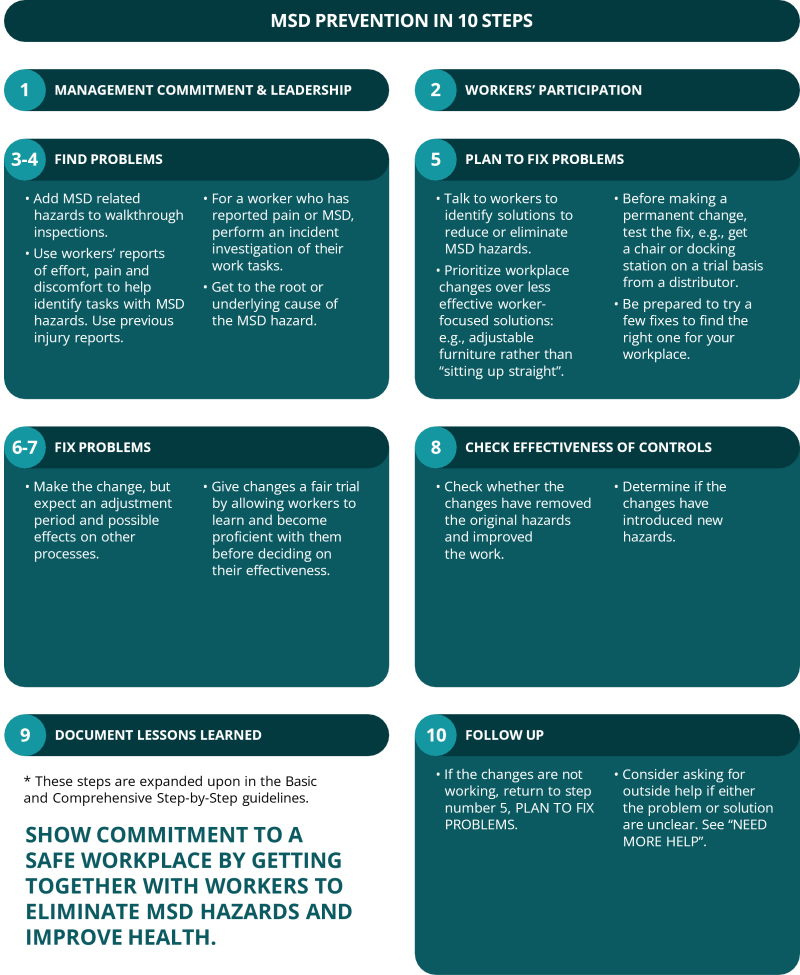On this page
Introduction
Back and shoulder pain, tennis elbow and other Musculoskeletal Disorders (MSD) are a major cause of workplace pain, discomfort, disability and costs. Help workers in pain now – and prevent it in the future – by improving your workplace. Eliminating MSD hazards is one part of creating a safe workplace.
Employers are responsible for taking every precaution reasonable in the circumstances for the protection of a worker under the Ontario Occupational Health and Safety Act. This includes improving the workplace and implementing measures to protect workers from all hazards, including those related to musculoskeletal disorders.
Small changes can make a big difference! A workplace free of MSD hazards protects workers now, allows injured workers to return to their jobs more easily, and allows more people to perform those jobs: male or female; old or young; tall or short.
Quick Start Guideline Introduction Video
New to the MSD prevention quick start guidelines? This short animated video shows what is included in the quick start guidelines, and provides examples of how they can be used to prevent MSD in your organization today.
Small changes can make a big difference! A workplace free of MSD hazards protects workers now, allows injured workers to return to their jobs more easily, and allows more people to perform those jobs.

Quick Start Guideline: Folder
The PDF creates a folder that can hold the mini-posters and gives information about MSD and Prevention and how to use the mini-posters. The folder and mini-posters together are a self-contained resource.
Quick Start Guideline: Mini Posters
The mini-posters describe six common MSD workplace hazards. Please see Work and MSD Hazards for a more complete description of MSD hazards.
Employers are responsible for taking every precaution reasonable in the circumstances for the protection of a worker under the Ontario Occupational Health and Safety Act. This includes improving the workplace and implementing measures to protect workers from all hazards, including those related to musculoskeletal disorders.
How to use the posters?
- Use the posters as guides during workplace walkthroughs and inspections. On the back of the poster, write observations and ideas about possible fixes for hazards.
- Use the posters as a script to aid workers, supervisors and others during safety or toolbox talks. Use the discussion to brainstorm possible fixes.
- Use the posters in the lunchroom or on the Health & Safety board to alert workers to potential MSD hazards in their work and their relationship to pain and discomfort.
- As a reminder to keep looking for improvements!
Each poster describes a common workplace hazard that can lead to an MSD. It also gives ideas on how to fix it. MSD hazards can be found in all sizes of workplaces and in all sectors. You may recognize some or all six hazards in your workplace. This tells you that your workplace needs a plan for MSD prevention action.
Store it Off the Floor
Store - and work on - objects between hip and chest height.
Keep it Close
Store objects or work close to the belly button.
Hands Below Head
Work with the hands below the head.
Look Straight Ahead
Work with the head straight and level.
Get a (Good) Grip
Tools and gloves should fit the hands, keep hands and wrists strong.
Change It Up
A well-organized job has variety and pauses that give the body time to recover.
Work Shouldn't Hurt
Find jobs that may have MSD hazards.
Quick Start Guideline: 11" x 17" Poster
Use the 11” x 17’’ poster in the lunchroom or on the Health & Safety board to alert workers to potential MSD hazards in their work and their relationship to pain and discomfort.
What do the colours mean?
Making a start
Starting is the most important part of reducing back pain, shoulder tendinitis, tennis elbow and other Musculoskeletal Disorders (MSD). This package will give you a good start. Some of the ideas may seem very simple, but you can substantially reduce MSD hazards by applying these ideas throughout your workplace (and at home).
The mini-posters give you the general idea behind the solution. For example, store it off the floor shows how to store objects. It’s the same rule for storing boxes in an office, moving parts in manufacturing, or setting up stands and work surfaces for heavy tasks in construction.
Actions
- Jump straight in. Start using these posters in your workplace inspections and toolbox talks and make changes to remove or reduce any hazards identified.
- Follow the 10 steps for a more systematic approach.

Want to search the resource library?
Find all the available resources on the MSD prevention website, including posters, videos, and links to relevant websites.



